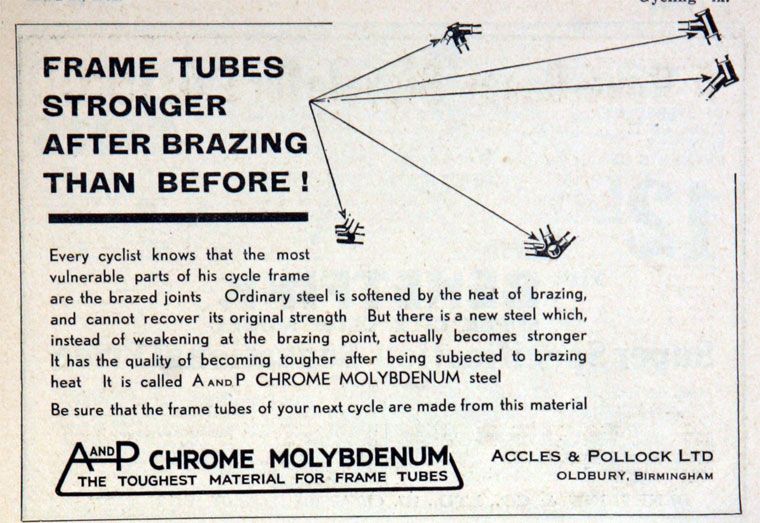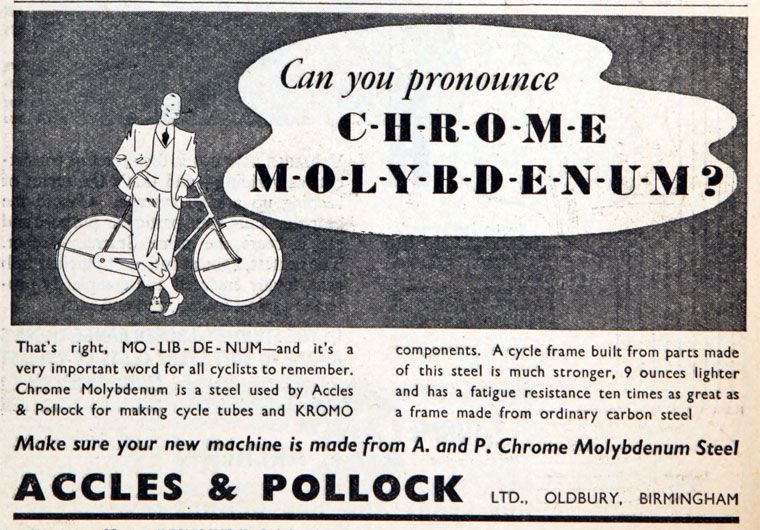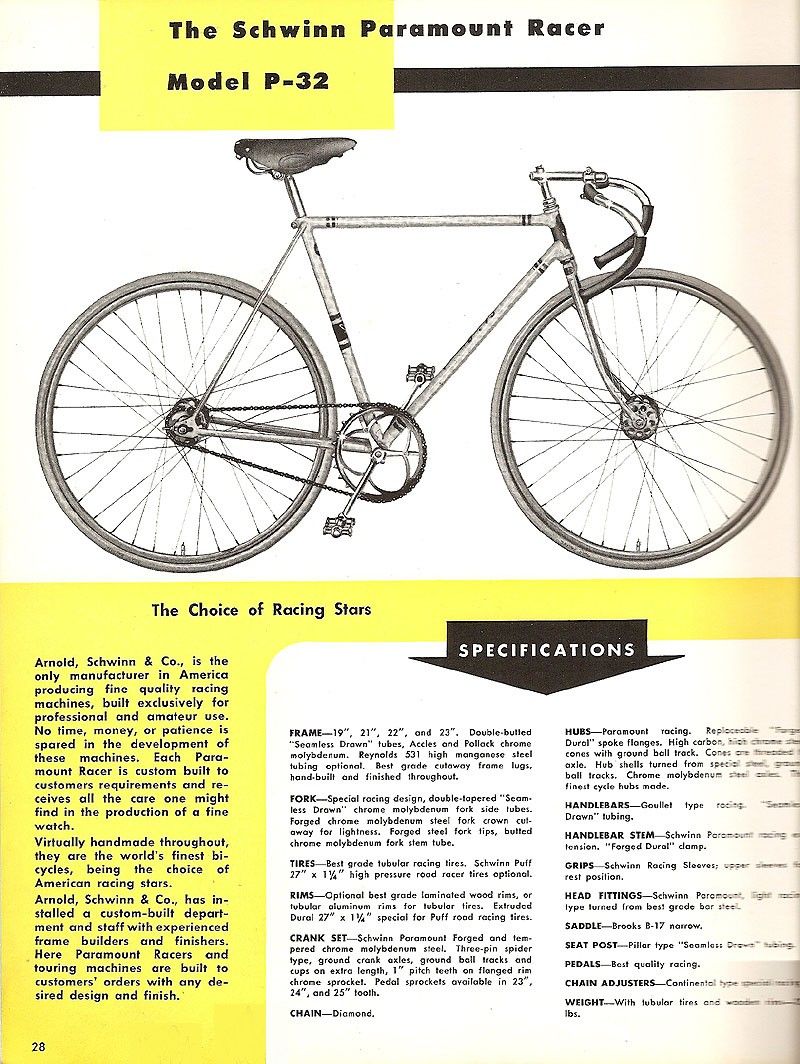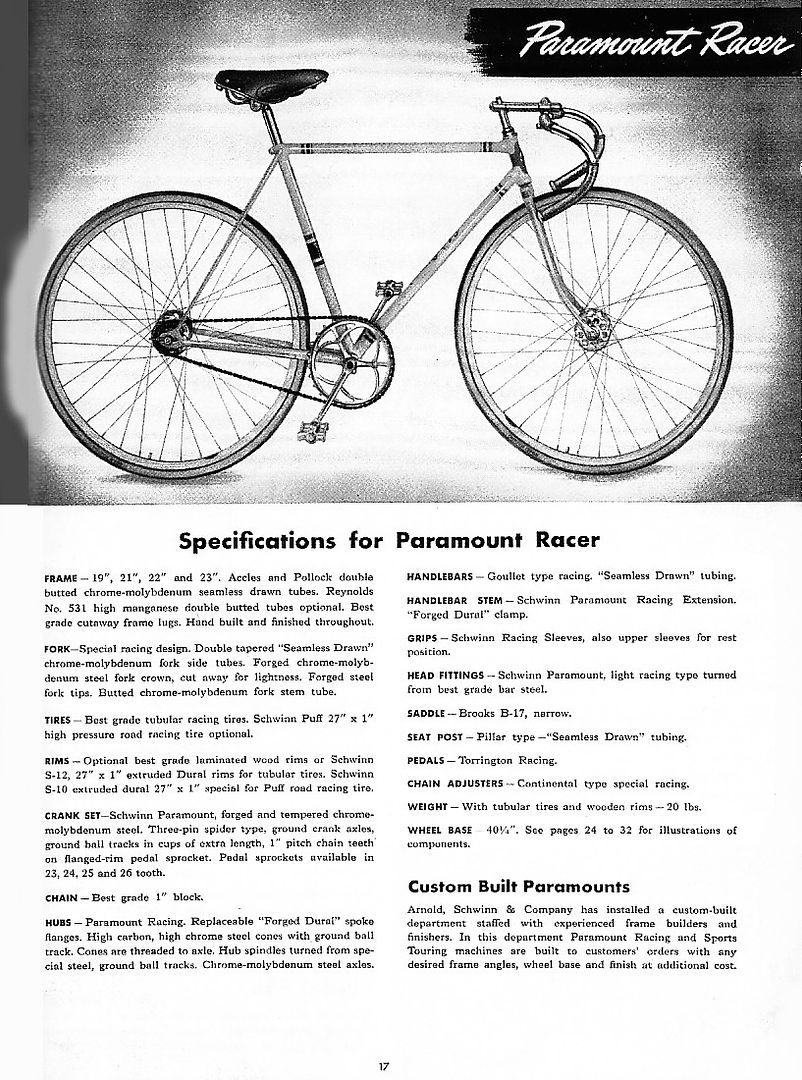When was chrome moly first used in frames?
#1
Senior Member
Thread Starter
Join Date: Jun 2007
Posts: 131
Mentioned: 0 Post(s)
Tagged: 0 Thread(s)
Quoted: 0 Post(s)
Likes: 0
Liked 0 Times
in
0 Posts
When was chrome moly first used in frames?
I was talking to a friend today and he said his Novara was from the eighties and that was when chrome moly was first used in bike frames. My answer was a resounding no and I told him my custom made frame from 1980 was made with Tange No.2 and predates his Tange Infinity frame by years.
So, can the collective wisdom of C&V enlighten me as to when chrome moly tubing was first used in bike frames?
So, can the collective wisdom of C&V enlighten me as to when chrome moly tubing was first used in bike frames?
#2
Senior Member
Join Date: Sep 2009
Location: EagleRiver AK
Posts: 1,306
Mentioned: 0 Post(s)
Tagged: 0 Thread(s)
Quoted: 28 Post(s)
Likes: 0
Liked 60 Times
in
33 Posts
Pretty sure that 4130 CrMo has been around for at least 70 years, probably longer. Reynolds 531 is not CrMo , it contains Manganese as a main alloy ingredient but it is fairly comparable to CrMo and 531 dates back to the 1930's.
#3
Stop reading my posts!
Join Date: Sep 2004
Posts: 12,579
Mentioned: 89 Post(s)
Tagged: 0 Thread(s)
Quoted: 1443 Post(s)
Liked 1,059 Times
in
784 Posts
actually 531 is older than the '30s, just didn't see use in bicycle frames until (about) 1928 or so. There certainly were frames made from chromium-molybdenum steel well before "the eighties", plenty of Columbus frames from the '60s (maybe earlier, too) were made of it, certainly some early Schwinns, too .
But it's an interesting trivia question: when was the first use of chrome-moly steel in a bike frame that can be documented.
But it's an interesting trivia question: when was the first use of chrome-moly steel in a bike frame that can be documented.
#4
Decrepit Member
In the thirties, Accles & Pollock chromium-molybdenum tubing was widely used by high end British framebuilders.
This ad is from 1931.

This one for Accles & Pollock "KROMO" brand chromoly is from 1936.

This ad is from 1931.

This one for Accles & Pollock "KROMO" brand chromoly is from 1936.

#5
Decrepit Member
Reynolds 531 was introduced in 1936, although Reynolds had "H.M." (High Manganese) labeled tubing earlier.
1937 531 catalog cover.

High Manganese (pre-531) decal.

1937 531 catalog cover.

High Manganese (pre-531) decal.

#6
Senior Member
Join Date: Sep 2009
Location: EagleRiver AK
Posts: 1,306
Mentioned: 0 Post(s)
Tagged: 0 Thread(s)
Quoted: 28 Post(s)
Likes: 0
Liked 60 Times
in
33 Posts
Just as with titanium and carpet fiber bikes over the past 30 years ago, racing bike frames have always been near the forefront of available technical developments. Aside from military aircraft, there are few other common applications that so profoundly benefit from the latest tubing technology and materials as do bikes. I recently read that briefly around 1890, before internal combustions engins became sufficiently powerfull and reliable, track racing bicycles actually held the world speed record as the fastest vehicle, definitly cutting edge tech for the day.
#7
Senior Member
Join Date: Nov 2004
Posts: 23,223
Mentioned: 654 Post(s)
Tagged: 1 Thread(s)
Quoted: 4722 Post(s)
Likes: 0
Liked 3,036 Times
in
1,874 Posts
In the thirties, Accles & Pollock chromium-molybdenum tubing was widely used by high end British framebuilders...
#8
Senior Member
Join Date: Nov 2004
Posts: 23,223
Mentioned: 654 Post(s)
Tagged: 1 Thread(s)
Quoted: 4722 Post(s)
Likes: 0
Liked 3,036 Times
in
1,874 Posts
I'm pretty sure that the fastest vehicles during that period were steam locomotives. When Mile-A-Minute Murphy did his record breaking ride in 1899, he drafted behind a train.
#9
Decrepit Member
Another little tidbit is that Schwinn offered a choice of Accles & Pollock chromoly or Reynolds 531 tubing in the early post-war Paramounts.


#10
Old fart
Join Date: Nov 2004
Location: Appleton WI
Posts: 24,784
Bikes: Several, mostly not name brands.
Mentioned: 153 Post(s)
Tagged: 0 Thread(s)
Quoted: 3587 Post(s)
Liked 3,400 Times
in
1,934 Posts
IIRC, Columbus started out making chrome-moly tubing in the 1920s for the aircraft industry and only later branched out to provide bicycle frame tubing.
#11
Stop reading my posts!
Join Date: Sep 2004
Posts: 12,579
Mentioned: 89 Post(s)
Tagged: 0 Thread(s)
Quoted: 1443 Post(s)
Liked 1,059 Times
in
784 Posts
I'd forgotten about Accles and Pollock tubing...how could anyone forget a name like that?

Anyhow, to go back to the OP's question: it would seem that the first use of chrome-moly tubing would have to something made from A&P's Kromo tubing, which was in use for bicycle frames as early as the '30s, including the CCMs that T-Mar mentioned, but an earlier example may come from a UK builder such as Hobbs of Barbican, Thanet or Rattray's "Flying Scot".
At least that's where I'd be looking for the final word in "who's first?".
Last edited by unworthy1; 03-23-13 at 10:23 AM.
#12
Senior Member
Join Date: Nov 2004
Posts: 23,223
Mentioned: 654 Post(s)
Tagged: 1 Thread(s)
Quoted: 4722 Post(s)
Likes: 0
Liked 3,036 Times
in
1,874 Posts
As for it's use in aircraft, it was not introduced until sometime after the war. During the Great War, most aircraft used wooden frames, with Fokker being the notable exception. They used carbon steels, typically 1010, 1015 and 1018 depending on the year and application.
#13
Bicycle Repair Man !!!
By the turn of the century passenger trains were able to sustain straight run speeds of 70 mph with average speeds being in the 40's... prior to super heated steam engines the average train plodded along at an average of 20 mph.
#14
Senior Member
Join Date: Nov 2009
Location: Fayetteville, NC
Posts: 346
Bikes: 2013 Rivendell Sam, 1996 Bianchi Milano, 1994 Trek 820
Mentioned: 0 Post(s)
Tagged: 0 Thread(s)
Quoted: 13 Post(s)
Likes: 0
Liked 8 Times
in
4 Posts
An interesting connection is that chromoly steel tubing made superheated steam boilers and turbines possible/safe/reliable (on land and sea). Stainless steel based on chromoly steels did the same for jet engines and later, knives.
#15
Senior Member
Join Date: Aug 2010
Location: south kansas america
Posts: 1,910
Bikes: too many
Mentioned: 11 Post(s)
Tagged: 0 Thread(s)
Quoted: 411 Post(s)
Liked 234 Times
in
140 Posts
Not to put too fine a point on it, but the info on Reynolds 531 is a bit off topic, since it's steel strengthened with manganese, not chrome molybdenum. To add to the original posters question, why did chromo become so available and affordable in the 1980's? It seems that chromo made inroads to a level of bicycles just a step above entry level. Was it just the competition between the various bicycle companies? Did it become the buzzword for the market at that time, something a novice bicycle purchaser would recognize as a "quality" product?
#16
Senior Member
Thread Starter
Join Date: Jun 2007
Posts: 131
Mentioned: 0 Post(s)
Tagged: 0 Thread(s)
Quoted: 0 Post(s)
Likes: 0
Liked 0 Times
in
0 Posts
To add to the original posters question, why did chromo become so available and affordable in the 1980's? It seems that chromo made inroads to a level of bicycles just a step above entry level. Was it just the competition between the various bicycle companies? Did it become the buzzword for the market at that time, something a novice bicycle purchaser would recognize as a "quality" product?
Was it only in the 1980s that chromoly became widely used in frames that were less than top of the line? I remember reading about tubing like Columbus SL, Ishiwata and Tange No.2 towards the end of the 70s, but can't remember if they were only in high end frames. Did tube manufacturing technology advance by the mid-70s to bring costs down to a level that it was cost-effective for use in mass-produced frames for a mid-level market?
I have a Fuji Finest with a serial number and other clues such as the fork crown which dates it to 1971. The label on the seatpost says 'Chrome Moly" and I think that at that time the Finest was not the top line Fuji (in their entire line, not just the US market), maybe a step or two down.
Thank you all for for your responses. This is becoming very interesting reading indeed.
#17
Senior Member
Join Date: Apr 2008
Location: Maidstone, Kent, England
Posts: 2,637
Bikes: 1970 Holdsworth Mistral, Vitus 979, Colnago Primavera, Corratec Hydracarbon, Massi MegaTeam, 1935 Claud Butler Super Velo, Carrera Virtuoso, Viner, 1953 Claud Butler Silver Jubilee, 1954 Holdsworth Typhoon, 1966 Claud Butler Olympic Road, 1982 Claud
Mentioned: 0 Post(s)
Tagged: 0 Thread(s)
Quoted: 10 Post(s)
Liked 11 Times
in
10 Posts
#18
Senior Member
I would think that CroMo in lower end bicycles in the late '70s and '80s is probably related to its low cost, high quality production in Japan at the time.
#19
Insane Bicycle Mechanic
Join Date: Mar 2008
Location: other Vancouver
Posts: 9,835
Mentioned: 34 Post(s)
Tagged: 0 Thread(s)
Quoted: 802 Post(s)
Liked 703 Times
in
376 Posts
In the late '70's, lower-line bikes were lugged hi-tensile steel, with lugged straight-gauge cro-mo one step up. The oddballs of the era were the Schwinn Super Sport/Sports Tourer/Superior, which were fillet-brazed chrome-moly.
__________________
Jeff Wills
Comcast nuked my web page. It will return soon..
Jeff Wills
Comcast nuked my web page. It will return soon..
#20
Decrepit Member

#21
Stop reading my posts!
Join Date: Sep 2004
Posts: 12,579
Mentioned: 89 Post(s)
Tagged: 0 Thread(s)
Quoted: 1443 Post(s)
Liked 1,059 Times
in
784 Posts
Funny that way back in 1931 A&P were hard at work educating the public as to the quality of their Kromo tubing, and how to pronounce "molybdenum"! Great scans, thanks to Scooper!!
#22
Senior Member
Join Date: Nov 2004
Posts: 23,223
Mentioned: 654 Post(s)
Tagged: 1 Thread(s)
Quoted: 4722 Post(s)
Likes: 0
Liked 3,036 Times
in
1,874 Posts
To add to the original posters question, why did chromo become so available and affordable in the 1980's? It seems that chromo made inroads to a level of bicycles just a step above entry level. Was it just the competition between the various bicycle companies? Did it become the buzzword for the market at that time, something a novice bicycle purchaser would recognize as a "quality" product?
Edit: During the 1970s boom, seamed tubing was considered inferior and there were a number of reported failures. Consequently, high end bicycles used only seamless tubing. However, the reliability of the mid-1980s sets overcame this stigma. When True Temper came onto the scene, all their sets used seamed tubing.
Last edited by T-Mar; 03-24-13 at 10:47 AM.
#24
Retro Grouch
Join Date: Oct 2007
Location: Santa Cruz
Posts: 2,210
Bikes: Yes
Mentioned: 0 Post(s)
Tagged: 0 Thread(s)
Quoted: 3 Post(s)
Likes: 0
Liked 1 Time
in
1 Post
Reynolds butted CrMo (501) came along in the 80's. Pretty much all the large manufactures started building Tig welded 501 frames as the process is much faster than lugs and some say create a stronger weld do to the short heating and cool off times, with the advantage of lighter tubing of the interior butting for medium level bicycles..
Last edited by onespeedbiker; 03-24-13 at 05:14 PM.
#25
Senior Member
Join Date: Oct 2004
Posts: 1,973
Mentioned: 0 Post(s)
Tagged: 0 Thread(s)
Quoted: 39 Post(s)
Likes: 0
Liked 32 Times
in
22 Posts
I believe that Mannesmann was making Cr-Mo tubing in the 20's already. Columbus used Mannesmann tubing as the basis for most of their tubing. I have had a few bikes with Mannesmann tubing from the 30's-40's that were very light and more than likely Cr-Mo.








